
SF3729 Foundation pot
The 'House I' sequence produced a very large assemblage of pottery, amounting to some 23,770 sherds weighing c. 290.5kg. The material was initially visually scanned very rapidly to produce a preliminary spot date on the basis of the range of wares present. The sigillata (samian) was extracted for separate study.
Following the spot dating exercise, the sigillata has been analysed, catalogued and quantified by Paul Tyers; Joanna Bird confirmed the fabric identifications and Brenda Dickinson has looked at some of the stamps. It was considered that the sigillata could potentially act as the most sensitive chronological indicator for the deposits, which were likely to fall within the main supply periods for South and Central Gaulish kilns. For this reason the sigillata has been subjected to detailed study and fully quantified as a discrete exercise by sherd count, weight and estimated vessel equivalence (EVE) to source. Given the lack of time, financial constraints and the size of the assemblage, it was decided not to quantify the remainder of the assemblage to the same level of detail at this stage. If particular deposits prove to be of further interest, they can be returned to at a later date.
The main assemblage was sorted into broad fabric categories and quantified by sherd count and weight. For named, traded, wares the National Roman fabric reference collection was used to code the fabrics (Tomber and Dore 1998). Some of the early coarsewares familiar from previous work at the Forum-Basilica were coded using these codes (Timby 2000). A significant proportion of the assemblage comprises grey sandy wares of various grades. While the majority of these derive from the Alice Holt industry, a good number probably come from other local and regional sources, possibly Staines, Colne Valley etc., and it was felt that it would not be useful to try and discriminate the various fabrics at this stage, so the greywares are subsumed for the most part under Alice Holt and allied reduced wares. The same methodology was applied to oxidised and white sandy wares. Little work has been done to try and source local and regional providers to Silchester, partly due to the poor publication of some of the main potential sources, for example Staines, and partly because the material is not very distinctive. Unsourced and unnamed wares are thus treated generically and grouped according to fineness of paste and firing colour. The data were entered onto an MS Excel spreadsheet. The information has been further distilled to provide ten summary tables for the defined objects.
Following a general commentary on the sigillata by Paul Tyers, the assemblage from each Object, as defined by the excavators, is described in greater detail using the building designations.
The Terra Sigillata assemblage from the contexts constituting the ten defined Objects comprises 1138 sherds, 21.77 EVE, 7094g, divided between the principal fabrics as shown in Table 1 in Pottery Summary Tables (PDF 22Kb).
So 56% of the assemblage by weight is Central Gaulish ware, and 40% from South Gaul (or 43% and 54% by EVE respectively), with the other sources making small contributions only.
Taking the assemblage as a whole (irrespective of context, residuality etc.) one might point to the small proportion of decorated wares. Only 79 sherds (0.45 EVE) can be assigned to decorated forms (that is 6.9% of the sherds, or 2% of the EVE measure). This contrasts somewhat with the data presented by Willis (2005, table 42) where the average percentage of decorated vessels from a sample of 110 sites ranges from c. 17% to over 35%, depending on the type of site (civil, military, rural etc.). The Willis data are based on a 'vessels represented' count, which is difficult to compare with the EVE measures here, but even taking this into account the proportion of decorated wares in the Silchester groups seems low.
The earliest phase of Timber Building 1, Room 1, produced some 1705 sherds of pottery weighing 20,181g. The material was fairly well fragmented, but not excessively so, with an overall average sherd size of 11.8g. The assemblage comprised a mixture of imports (finewares, mortaria and amphorae) accounting for 4.8% by sherd count, very few recognisable regional imports, but a very high proportion of Alice Holt and allied greywares (56.4%) and other presumed local wares (Table 2).
The imports include a small group of South Gaulish sigillata (34 sherds, 0.63 EVE, 263g) but also examples of a Drag. 35 and 18/31 from Les Martres-de-Veyre (7 sherds, 0.07 EVE, 20g), suggesting an early 2nd-century date for the group. Other fineware imports are restricted to black eggshell wares, Central Gaulish colour-coated beaker with barbotine decoration and a possible lamp. Imported mortaria include worn fragments of North Gaulish forms and the amphorae are limited to several sherds of Baetican type, largely Dressel 20 and Gaulish fabrics. Regional sources represented in this group are limited to several sherds of Verulamium whiteware including a ring-necked flagon, jar and mortaria. The flagon has a larger upper ring typical of the early 2nd century. Also present is a mortaria probably from the kiln at Wiggonholt, West Sussex. The British finewares include several sherds from mica-slipped oxidised vessels among which is a folded beaker and curved wall dish; some sherds are blackened, a recurrent feature with the mica-slipped bowls and dishes in the assemblage as a whole, which presumably relates to how they were used. Grey and black finewares are also well represented, the latter including a decorated ‘London-style’ bowl and the former barbotine dot-decorated poppyhead beakers, and a ring-and-dot decorated beaker, possibly a London product. These wares point to a Flavian-Trajanic date. Also noticeably typical of this period at Silchester is the present of a distinctive oxidised ware, largely occurring as flat rim bowls and lids, again typologically dating to the Flavian-Trajanic period. Collectively, oxidised wares account for 6% of Object O50029 and, together with the mica-slipped and white-slipped varieties, suggest a relatively local source.
The bulk of the assemblage comprises coarsewares, in particular Alice Holt greywares (56.4%) and flint-tempered Silchester ware at 13.7%. The latter must be at the end of its production period, if not beyond, and is thus likely to be largely residual along with the 1st-century grog-tempered wares. Later 1st or early 2nd-century handmade grog-tempered storage jars were probably replacing the flint-tempered jars at this point and this accounts for 4.9% of the assemblage. Among the Alice Holt products are flat-rimmed bowls and dishes, Atrebatic bowls, flagons (Lyne and Jefferies 1979, class 8.1), lids and jars, both necked everted and beaded-rim varieties.
On balance, therefore, the pottery associated with Timber Building 1, Room 1 belongs to the later 1st and early 2nd century, with the latest material having a terminus post quem in the early 2nd century.
A significantly smaller assemblage of pottery was recovered from Room 2, amounting to some 594 sherds weighing 6845g. In terms of sherd fragmentation, the material is similar to that from Room 1 with an average sherd size of 11.5g.
The balance of material is quite similar to Room 1 in terms of coarsewares to finewares and imports but the fabrics present show some significant differences. Continental imports account for 8.4% by count although the number of finewares, particularly the sigillata, is less than that recovered from Room 1 (Table 3).
Only a small group of sigillata is present, including both South Gaulish (15 sherds, 0.30 EVE, 55g) and Central Gaulish (Drag. 27, 33 and 30; 4 sherds, 0.11 EVE, 20g) wares, the latest being of Hadrianic-Antonine date. Other imported finewares include two residual terra nigra sherds, residual whiteware butt beaker and Central Gaulish colour-coated wares. The amphorae are all Baetican (Haltern 70 and Dressel 20) or Gallic in source. The dating from the finewares is diverse; some contexts appear to be only pre-Flavian, in particular C5298, C6082 and C6146; others suggest a later date, as do some of the coarsewares.
Regional imports include a small quantity of Dorset black-burnished ware, all from jars decorated with an acute-burnished lattice from C4153 and C5340, Verulamium whiteware and Oxfordshire mortarium. The latter include Young (1977) M2 and M4 with a production date of AD 100-170. British finewares include similar types to Room 1, with a fine black-ware bowl decorated in the ‘London style’ and fine greyware barbotine dot-decorated beaker. Oxidised wares account for 5.1% and white-slipped oxidised wares for 3.4%. The latter includes a ring-necked flagon with larger upper rings typical of the early 2nd century.
The proportions of Alice Holt and Silchester wares are similar to those in Room 1 at 56.4% and 12.6% by count. Sherds of grog-tempered storage jar accounted for 3.2%.
On balance, the chronology suggests a broadly similar date to Room 1 but the sigillata and the Dorset black-burnished ware could indicate a date in the Hadrianic period, slightly later than that indicated from the assemblage in Room 1.
Pottery recovered from layers associated with Timber Building 2, phase 1, only amounted to some 113 sherds weighing 872g. Compared to Timber Building 1 the material is very fragmented with an average sherd weight of just 7.7g (Table 4).
Continental imports are limited to sherds of white eggshell ware, North Gaulish whiteware butt-beaker, a piece of Central Gaulish green-glazed flask and one sherd of Baetican amphora, probably from a Haltern 70. There is no sigillata present. The only regional import is a single sherd of Verulamium ware. As above, the coarsewares are dominated by the same range, but the emphasis has changed from Alice Holt and allied wares, which account for 27.4%, to Silchester flint-tempered wares at 32.7%. Also well represented are wares with a mixed sand/grog/flint temper, and includes material similar to that recovered from the kilns, excavated beyond the North Gate (May 1916). This mixed group accounts for 21.2% and appears to date to after the conquest.
The group is very small but includes nothing which needs to date to after the pre- or early Flavian period.
Period 2 of the central range of buildings produced a slightly larger assemblage with some 1140 sherds weighing 10525g. Less fragmented overall than phase 1, the material is still quite small with an average sherd weight of just 9.2g. This is reflected in a mixture of some larger sherds; for example the profile of a lid is present from layer 1975, but also some smaller, finer, sherds (Table 5).
Continental imports account for 7.7% of the assemblage, with finewares and samian (sigillata) together accounting for 6.4%, a moderately high percentage. There is a small group of South Gaulish sigillata (23 sherds, 0.24 EVE, 66g) of Neronian and Flavian date, and two sherds of the footring of a cup (6g) in the Montans fabric. A single Rheinzabern sherd from C5784 is presumably intrusive. The finewares include a large quantity of Gallo-Belgic wares including both terra nigra, terra rubra (fabrics TR1A, TR1C, TR2 and TR3) and whitewares. Forms include Camulodunum (Cam) types 4, 8, 56, 74-77, 112 and 113. Other imports include a sherd of Central Gaulish micaceous terra rubra platter, a wall-sided mortaria and amphorae. The mortaria is in a white-slipped, orange, granular fabric and has a worn interior; the source is unknown. The amphorae include sherds of Baetican, Gallic and Palestinian type; the latter from a Cam form 189 (carrot amphora).
Regional wares include Verulamium white-ware with both flagon and mortaria and a single sherd of Dorset black-burnished ware. The latter came from the same layer as the late samian C5784, and may be intrusive, or the layer may not be part of this group. The local and unknown wares replicate fabrics and forms from the assemblages already described. Alice Holt and allied greywares account for 33.9% and Silchester flint-tempered wares for 22.1%. First-century grog-tempered wares and mixed-temper wares are also well represented. The Alice Holt wares include lids, Atrebatic bowls, beakers, lid-seated jars and beaded-rim jars. A single piece of briquetage was present in C5401.
The assemblage from Object O50017 appears to contain a marked quantity of residual material, the grog-tempered wares, along with much of the Gallo-Belgic material, include pre- and potentially early conquest vessels. The sigillata, with the exception of one sherd, suggests a Flavian terminus post quem. The slightly higher proportion of Alice Holt ware to Silchester ware would also intimate a date in the latter part of the 1st century and a Flavian date is suggested for the phase, with a small amount of potentially intrusive 2nd-century material.
A moderately small assemblage of 518 sherds weighing 6547g came from Object O50034. The average condition of the sherds has improved compared to other elements of Timber Buildings 1 and 2, with an average sherd weight of 12.6g (Table 6).
The proportion of continental imports is high at 9.6%, 9% of which is sigillata and fineware. The small group of sigillata includes South Gaulish wares (20 sherds, 0.26 EVE, 61g) of Neronian or early-Flavian date and two sherds of Italian-type ware (cup of Conspectus 22.1 and plate; 5g), which are presumably residual in this context. Apart from a single sherd of Central Gaulish roughcast colour-coated beaker and a Campanian flagon, all the fineware comprises Gallo-Belgic wares (fabrics TR1A, TR1C, TR2, TR3) and whiteware. Forms include at least four TR3 beakers, a pedestal beaker (Cam 74-77), a Cam 5 platter and other platters and Cam 113 butt beaker, suggesting a pre- and/or early post-conquest date.
The only recognisable regional import is a butt beaker probably made in the Abingdon area (Timby 2000, fabric S16). The local coarsewares are dominated by Silchester ware (43.5%) and mixed temper wares at 19.8%. Alice Holt wares only account for 18.7%.
The high proportion of Gallo-Belgic fineware very much mirrors the assemblage from the rest of Timber Building 2 (Object 50017) above. This assemblage would appear to be broadly the same date, with pre-conquest and potentially conquest-period wares. The sigillata indicates a Neronian or early Flavian date. The coarsewares also reflect a potentially slightly earlier or broadly contemporary date to Object O50017.
This structure produced the smallest assemblage out of all those under review, with 334 sherds weighing 2797g. The sherds are well fragmented, the overall average sherd weight being just 8.4g (Table 7).
Continental imports contribute 5.4% by count, most of which are finewares. The small group of South Gaulish sigillata (8 sherds, 0.20 EVE, 17g) is of pre- or early-Flavian date. Other imports include single sherds of Central Gaulish flagon and Gallic amphora and Gallo-Belgic finewares (TR1A, TR1C, TR3 and whitewares). The only regional import is a single Verulamium ring-necked flagon.
As with the adjacent Timber Building 2, Room 6 (Object O50034), flint-tempered Silchester ware dominates the coarsewares, accounting for 43.4% of the assemblage followed by Alice Holt and allied greywares at 27.2%. Silchester ware includes a complete beaded-rim jar (FSF03729) from C3925, possibly a foundation deposit, and the substantial part of a second complete jar from context 5556 (SF3967). All other wares are only present in minor quantities; the fine greywares include barbotine dot-decorated beaker. The latest sherds in the assemblage would, like those from O50034 and O50017, carry an early Flavian tpq.
Masonry Building 1 produced a substantial assemblage of 2354 sherds weighing 31421g, with an overall average sherd weight of 13.3g (Table 8). The assemblage is mixed in condition, with some larger sherds and in some cases several sherds probably from single vessels.
Continental imports account for 10.4% by count and, for the first time, sigillata is more prolific than other finewares. The sigillata assemblage is dominated by South Gaulish wares (82 sherds, 2.51 EVE, 417g), but includes two sherds from Montans (including a Drag. 15/17, 3g), six sherds from Les Martres-des-Veyre (Drag. 18/31, 36, 42 and Curle 11; 0.10 EVE, 38g), including a stamp of Nicephor i (AD 100-20) (FSF03164), and other Central Gaulish wares (Drag. 18/31, 33; 15 sherds, 0.65 EVE, 162g). The latter suggest a Hadrianic date for the group.
Many of the finewares are residual, in particular several sherds of Gallo-Belgic wares (TN, TR1A, TR1C), whitewares and Lyons ware. Other finewares include Central Gaulish colour-coated cornice rim beakers, at least one with hairpin barbotine decoration, and another with teardrop barbotine. Slightly later is a Moselle black-slipped ware with white-painted decoration from C1900. A single sherd of Pompeian redware platter is also likely to be redeposited. The amphorae included Baetican types (Dressel 20 and Haltern 70), Cam 189, some unidentified sherds, and Gallic sherds, including one complete base with a footring. Two sherds of imported North Gaulish mortaria are also present.
The regional wares start to include other sources, in particular Colchester colour-coated beakers with roughcast decoration, Dorset black-burnished ware, Verulamium whiteware and Oxfordshire whitewares. The DOR BB1 comprises seven sherds, all from jars of 2nd-century type; the Verulamium ware includes a flagon and a mortarium flange showing the edge of a stamp (FSF03177). The Oxfordshire whitewares feature two examples of small flagons (Young 1977, type W18) from C3732 and C3751, which are conventionally dated to the second half of the 3rd century.
Alice Holt and allied greywares make up nearly half the assemblage at 46.5% by count. A diverse range of forms is present, including several platters copying imported forms (Lyne and Jefferies 1979, type 6.2), flagon, Atrebatic bowl, flat rim bowls, lids, and various jars (beaded-rim, necked, neckless, storage, bifid and flat rim). Residual 1st-century flint- and grog-tempered wares are still quite common, accounting for 17.5% by count. A large number of sandy oxidised wares feature in this group with reeded rim bowls, flagon, beakers, flat-rim bowls and lids. British finewares also include grey fineware beakers with flared rim and barbotine-dot decoration, whitewares with orange barbotine dots and oxidised wares with cream barbotine dots; many of these may be early Oxfordshire products. Also present is the lower part of a jar/beaker in a black ware with a finely polished exterior surface of unknown provenance from context 3973 (SF2658). The white-slipped oxidised ware features a particularly large flagon and a base, which had been deliberately holed after firing. Also among the coarsewares is the substantial part of a very large, semi-complete jar in Silchester flint-tempered ware from context 3973 (SF2377), which is clearly an antique by this time.
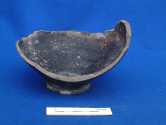
SF02658 - Lower part of Blackware jar or beaker of unknown provenance.
The dating of this group appears slightly mixed. The samian would suggest a Hadrianic tpq and this is broadly confirmed by most of the coarsewares, disregarding the obviously residual material. A few pieces point to a 3rd-century date, in particular the Central Gaulish black-slip beaker and the Oxfordshire flagons. Either these pieces are intrusive or some contexts are wrongly attributed to Object group.
Masonry Building 2 produced 1062 sherds of pottery weighing 14,884g. The sherds are moderately well preserved with an overall average sherd weight of 14g. There are some large sherds present as well as multiple sherds from single vessels (Table 9).
Continental imports account for 8.1% by count overall, with sigillata being the most frequently occurring ware, although still a small group, including South Gaulish wares (32 sherds, 0.28 EVE, 173g), one sherd of a Drag. 27 from Les Martres-de-Veyre (0.15 EVE, 21g) and other Central Gaulish wares (Drag. 27 and bowl; 16 sherds, 0.55 EVE, 88g). The latest pieces are of Hadrianic or early-Antonine date. All the other finewares are clearly residual, comprising Gallo-Belgic fabrics (TN, TR1A, TR1C, TR2, TR3 and whiteware). Imported coarsewares include one sherd of North Gaulish mortarium and eight sherds of amphorae, including Baetican, Gallic and unidentified sherds.
Regional wares form a minor component with four sherds of Verulamium whiteware, one from a very large mortarium, and Colchester colour-coated roughcast beaker. The high residual component is also reflected in the coarsewares, with 44.7% of the total assemblage comprising flint, grog and mixed-temper wares of 1st-century date. Among these is a small Silchester ware flint-tempered jar, probably complete when deposited in context 3320 (SF2039). Alice Holt wares and allied wares form the largest single group at 34.3%. Vessels include Atrebatic bowls, lids and various jars including necked-everted, beaded and lid-seated types. A complete bead-rimmed Alice Holt greyware jar was placed in context 3930 (SF2549). Sherds of a grog-tempered large storage jar make a significant contribution by weight, 16.9%, with several sherds from a single vessel from C4123. The unknown finewares include a large sherd from a fine greyware beaker with a sharply everted rim (C3601) giving 75% of the profile. The oxidised sandy group is also quite marked, with flat-rim bowls, lids and jars.

SF02549, excavated Alice Holt jar
The latest samian is Hadrianic or early Antonine, based on just four sherds from contexts C1818, C2023 and C3619. The absence of any Dorset black-burnished ware is notable and the only coarsewares supportive of a 2nd-century date are some of the Alice Holt wares and the oxidised sandy group. Either much of the material comprising this object is redeposited or there are a few aberrant contexts with later material skewing the overall dating and the object should be seen as Flavian.
Contexts associated with Timber Building 4 in Period 3 produced the largest of all the assemblages from the 'House 1' sequence, with some 9844 sherds weighing 124,016g. The overall average sherd weight is 12.5g suggesting considerable, but not excessive, fragmentation. The assemblage includes two complete vessels but few other obviously reconstructable vessels. The range of fabrics present is commensurately greater but there is still a high level of redeposition present (Table 10).
Continental imports collectively account for 8.3% by count of the assemblage, with samian alone accounting for 5.2%. The large group of sigillata includes South Gaulish wares of the 1st century (171 sherds, 4.66 EVE, 827g), one base-sherd of a cup in Italian-type ware (11g), presumably residual in this context; two sherds of Les Martres-de-Veyre (10g) including a Drag. 33 stamped by Indercillus (FSF02883), and a single sherd of a Drag. 31 in East Gaulish Rheinzabern ware. The largest element is the Central Gaulish wares (336 sherds, 4.39 EVE, 2592g), which include five stamped pieces by Lezoux potters (Table 11).
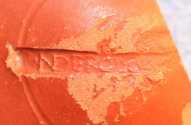
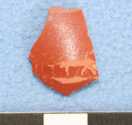


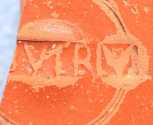
Showing (from left to right): SF2883 Samian stamp of Indercillus, SF2691 Samian stamp of Catullus ii, F2587, Samian stamp of Clemens iii, SF2686 Samian stamp of Reditus, SF3079 Samian stamp of Butrio
Decorated sherds are rare but among those present is a Drag. 37 in the style of Cinnamus. The plain wares are dominated by Drag. 31 and 31R (1.04 EVE), 18/31 (0.59), 33 (0.75) and 27 (0.43) and the rarer forms include Walters 79 (0.08 EVE), Drag. 38 (0.30), 36 (0.19), a fragment of a beaker similar to Déchelette 67 (0.07) and cups and dishes of Drag. 42, equivalent to Lezoux (Bet and Delor 2000) service D (forms 016 and 017a, 0.22 EVE) and E (forms 024 and 025a, 0.35 EVE).
Other imported finewares include 26 pieces of residual Gallo-Belgic wares, along with eggshell wares, Lyons ware and Central Gaulish white-slipped flagon. Slightly later in date are decorated colour-coated beakers from the Argonne, Cologne and Central Gaul. A single sherd of Pompeian redware constitutes the only coarseware import and most of the imported mortaria are North Gaulish with a single sherd of Rhenish mortarium probably from Soller. Amphorae, on the other hand, are quite diverse, with 146 sherds. Recognisable fabrics include Baetican (Haltern 70 and Dressel 20), Cadiz (Cam 186), Dressel 2-4 and Cam 189. A number of other fabrics present have the potential to be identified at a later date. Of note are two neck sherds from Dressel 20s (C3533 and C4152), which have been ground smooth suggesting reuse of the vessels. A lid fragment was recovered from C4170.
Regional wares are much more diverse, but still only contributing a small proportion of the overall assemblage at 3.6% by count. Several sherds of probable Colchester beaker are present. Dorset black-burnished ware starts to make a greater impact with 75 sherds and a more diverse repertoire, which includes jar, plain-rimmed dish, flat-rim dish and grooved-rim bowl. Early 3rd-century vessels came from contexts C3597, C4170 and C4174. Three sherds of the South-west variant also make their first appearance as do three sherds of South-west white-slipped ware, generally current from the later 2nd-3rd centuries. Oxfordshire whiteware is also well represented with mortaria (Young 1977 type M6) and a small flagon type W18, the latter from C4150. Sherds of Oxfordshire burnt whiteware and white-slipped ware also occur. Verulamium whiteware also occurs as flagons, including rimsherds from two very large vessels and mortaria. At least three flanges of the latter showed the edges of potters' stamps. Bowls and lids also occur.
As with other Flavian and later groups, Alice Holt and allied greywares dominate and in this case make up 56% by count of the assemblage 42% by weight. The range of forms is quite diverse with some earlier types still present, such as Atrebatic bowls and beaded-rim jars but also a greater range of jars and bowls including a grooved-rim example (C4151) and plain-rimmed dishes. Of particular note are two complete vessels FSF03095 and FSF03096. The former is a beaded-rim jar, which has been deliberately holed on one side; the latter is a necked cordoned jar/bowl. Other sherds of note among the greywares include one bodysherd with an incised X graffito (C3532); a rim sherd with a barbotine ?stem, perhaps imitating samian form Drag. 35/6 (C4179) and two sherds from a tripod bowl (C5843 and C4806).
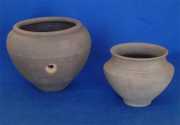
SF3095 and SF3096 Alice Holt jars
Although still present, Silchester flint-tempered ware and the other 1st-century coarsewares account for significantly less, making up 8.6% of the assemblage. These include the profile of a lid with a burnt lip, probably a Silchester product, from context 4170 (SF04565). The later, handmade grog-tempered storage jars are, however, well represented, accounting for 5.4% by count, but 14.1% by weight.
Of the other categories of wares, fine greywares and oxidised wares are particularly common. The former includes bowls, dishes and beakers with barbotine and combed decoration. The latter includes the standard 2nd-century range of bowls, flagons, jars and lids. One closed-form base has a number of holes through the base and walls made before firing (FSF03343, C4772). Although not prolific, both mica-slipped oxidised wares and shelly wares are well represented. The former includes a bobble beaker, an indented beaker, a burnt lid and a burnt plain curved-wall dish. The last item of note in this assemblage is a fragment of probable lamp chimney from C3905.
In terms of chronology, a mid- or late-Antonine date can be suggested for the samian assemblage and this would apply to the bulk of the coarsewares. The later coarsewares include some of the Dorset black-burnished ware, Oxfordshire wares and South-west white-slipped ware. The chronology of the greywares cannot, for the most part, be that closely refined. A few contexts appear to have some later material, potentially dating to the 3rd century.
Object O50046 produced the second largest assemblage from the house deposits, with some 6087 sherds weighing 72,034g and an average sherd weight similar to that of the other large assemblage from Object O50037 at 11.8g (Table 12).
Continental imports account for 10.3% of the group by sherd count of which the sigillata forms the largest component numerically. This large group of sigillata includes a wide range of fabrics. There are fragments of Drag. 15/17 in both Montans ware (0.02 EVE, 14g) and the early 'micaceous' Lezoux fabric (0.02 EVE, 2g). These, and the larger group of South Gaulish wares (170 sherds, 2.95 EVE, 1033g), are likely to be residual in this context. A single, base fragment of a Drag. 18 (24g) can be assigned to the Aldgate-Pulborough sigillata factory and shows the highly fired fabric characteristic of this workshop.
The Central Gaulish ware (178 sherds, 3.79 EVE, 1152 g) includes stamped vessels of three Lezoux potters (Table 13).
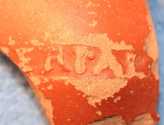
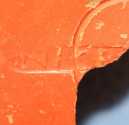
Left: SF1142 Samian stamp of Cerialis ii
Right: SF1320 Samian stamp of Nicephor ii
The decorated wares include a sherd of a Drag.37 in the style of Cerialis. The plain forms are dominated by Drag. 33 (1.69 EVE), 31 or 18./31 (1.43) and the rarer forms include Drag. 27 (0.30), 35 and 36 (0.13), 42 (Lezoux form 25, 0.07 EVE), Walters 79 and 80 (0.06), and sherds of Déch. 68 and 72 and Curle 21.
The other imported finewares still include a significant quantity of redeposited 1st-century wares (Gallo-Belgic, eggshell wares, Lyons ware) alongside various colour-coated beakers (Central Gaulish, Argonne, Cologne and Moselle). The imported mortaria also appear to be largely residual with Central Gaulish and North Gaulish vessels. The latter includes one stamped by VERANIUS (FSF04085). Amphorae are well represented, with the same range of types documented above. In addition there is a residual fragment of Campanian flagon.

SF4085 North Gaulish mortarium stamp of Veranius
Although regional wares only account for 5%, there is quite a diverse range present. The three most common fabrics are Dorset black-burnished ware, Verulamium whiteware and Oxfordshire whiteware. The DOR BB1 includes forms spanning the 2nd to later 3rd-4th centuries. Conical-flanged bowls from C1753, C1832 and C3313 are among the latest forms. The Oxfordshire whiteware includes mortaria (Young 1977) types M3 and M10 and further mortaria occur in Verulamium white-ware, including two edges of stamp and one stamp ‘FECIT’ (FSF02974). Several regional imports appear for the first time: British glazed ware, Hampshire grog-tempered ware, Shepton Mallet mortaria, Oxfordshire colour-coated ware, New Forest colour-coated and parchment ware. The first is residual, the latter are all likely to date to the 4th century.
Alice Holt and allied greywares still dominate the assemblage at 58.4%, but the frequent occurrence of Silchester ware (354 sherds) and, to a lesser extent, grog-tempered wares highlight the high levels of residuality in these deposits. Of note is the substantial part of a fine flint-tempered jar from C3313. The greywares include another sherd from a tripod bowl and a flanged bowl (C1140). Fine greywares, mica-slipped oxidised ware and oxidised wares are well represented. The mica-slipped wares include a tripod bowl and an indented decorated beaker, and of note among the oxidised wares is an unguent jar (C1796).
Other items of note from this group include two crucible fragments from C3252.
The assemblage from Object O50046 is extremely diverse in date. A great many contexts produced material solely of 1st- or 2nd-century date and the levels of redeposition appear very marked. The sigillata from this group as a whole suggests a mid- or late Antonine date. Set against this, however, are the later coarsewares. The New Forest wares come from eight contexts: C1397, C1461, C1545, C1753, C1811, C2190, C2456 and C2471. The Oxfordshire colour-coated wares come from some of the same contexts with, in addition, C1302 (with a 4th-century bowl), C1482, C1832 and C1948. Other late 3rd-4th-century types, such as the flanged bowls, came from C1140 and C3313. Disregarding two post-medieval sherds from C1914 and C3374 as intrusive, the tpq for the group as a whole appears to lie in the 4th century.
© Internet Archaeology
URL: http://intarch.ac.uk/journal/issue21/4/finds_pottery.htm
Last updated: Wed Sept 12 2007